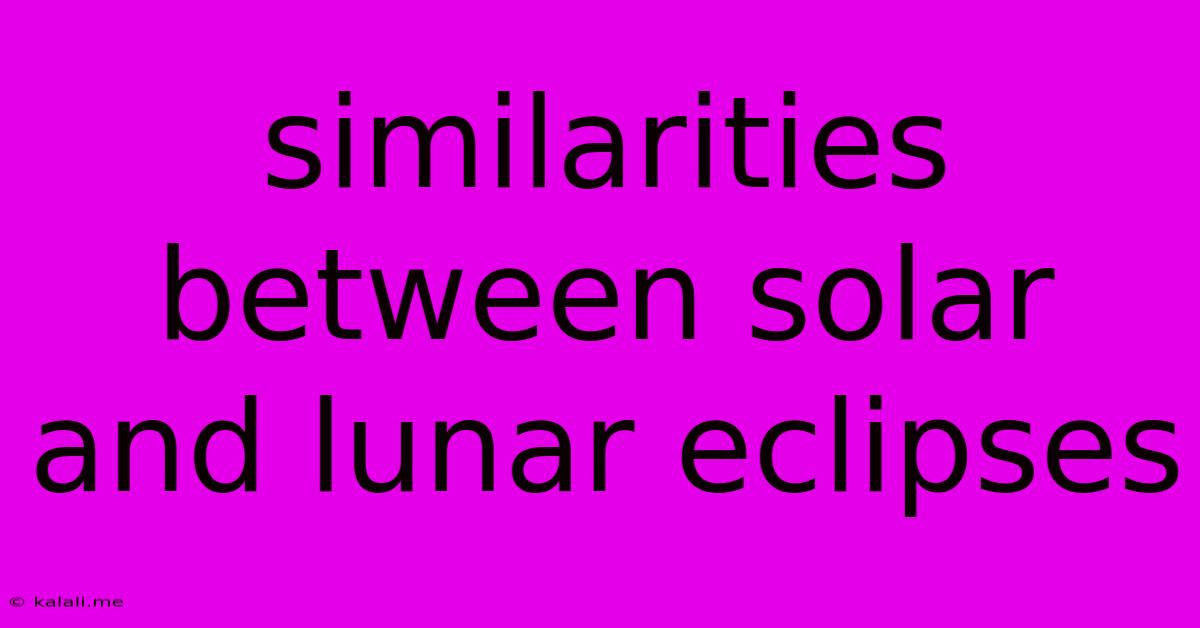Similarities Between Solar And Lunar Eclipses
Kalali
Jun 13, 2025 · 3 min read

Table of Contents
Striking Similarities: Unveiling the Common Threads Between Solar and Lunar Eclipses
While dramatically different in appearance, solar and lunar eclipses share surprising similarities. Understanding these commonalities provides a deeper appreciation for these celestial events and the mechanics behind them. This article delves into the key similarities, demystifying these awe-inspiring phenomena. This is a great resource for anyone interested in astronomy, space science, or simply curious about the wonders of the universe.
What are Solar and Lunar Eclipses?
Before diving into their similarities, let's briefly define each event. A solar eclipse occurs when the Moon passes between the Sun and Earth, casting a shadow on Earth. A lunar eclipse happens when the Earth passes between the Sun and the Moon, casting its shadow on the Moon. While seemingly simple, the precise alignment required for these events to happen makes them relatively rare occurrences.
Key Similarities Between Solar and Lunar Eclipses:
Here are the crucial aspects that connect solar and lunar eclipses:
1. Alignment of the Sun, Earth, and Moon:
This is the most fundamental similarity. Both eclipses necessitate a near-perfect alignment of the Sun, Earth, and Moon along a single straight line, or very close to it. Slight deviations from this alignment result in partial eclipses instead of total ones. The precise geometry of this syzygy is crucial for both events.
2. Influence of the Umbra and Penumbra:
Both eclipses involve the Earth's and the Moon's shadows. The umbra, the darkest part of the shadow, is where a total eclipse is visible. The penumbra, the lighter outer part of the shadow, results in partial eclipses. Understanding the interplay between the umbra and penumbra is vital to predicting the visibility and magnitude of both solar and lunar eclipses. This shadow geometry is a key element in both events.
3. Predictability Through Astronomical Calculations:
Thanks to our understanding of celestial mechanics, both solar and lunar eclipses are highly predictable. Astronomers can calculate the exact time, date, and location of these events years, even centuries, in advance. This predictability underscores the consistent and predictable nature of the orbital mechanics of the Earth-Moon-Sun system. Accurate predictions are based on the same fundamental calculations.
4. Cyclic Nature and Recurrence:
Both types of eclipses occur in cycles, although the specific patterns and intervals vary. These cycles are governed by the relative movements and orbital periods of the Earth and the Moon. While the precise timing differs, the cyclical nature of both events is a significant unifying feature. This cyclical pattern allows for long-term predictions.
5. Impact on Earth's Tides (Lunar Eclipses):
While solar eclipses don't directly impact tides in a noticeable way, lunar eclipses are indirectly linked. The gravitational pull of the Sun and Moon creates tides, and the alignment during a lunar eclipse can slightly amplify tidal forces, though the effect is subtle compared to the regular lunar tides.
Conclusion:
Despite their visual differences, solar and lunar eclipses share remarkable similarities rooted in the fundamental mechanics of our solar system. Understanding these shared characteristics enhances our comprehension of these captivating celestial events and the intricate dance of the Sun, Earth, and Moon. The striking similarities reveal the underlying unity behind these seemingly disparate phenomena, highlighting the elegance and predictability of our universe.
Latest Posts
Latest Posts
-
Instrument To Measure Height Above Sea Level
Jun 14, 2025
-
What Is The Lcm Of 15 18
Jun 14, 2025
-
Select The Statement That Is True
Jun 14, 2025
-
What Are All Of The Factors Of 44
Jun 14, 2025
-
One Effect Caused By Magnetic Leakage In Transformers Is A
Jun 14, 2025
Related Post
Thank you for visiting our website which covers about Similarities Between Solar And Lunar Eclipses . We hope the information provided has been useful to you. Feel free to contact us if you have any questions or need further assistance. See you next time and don't miss to bookmark.